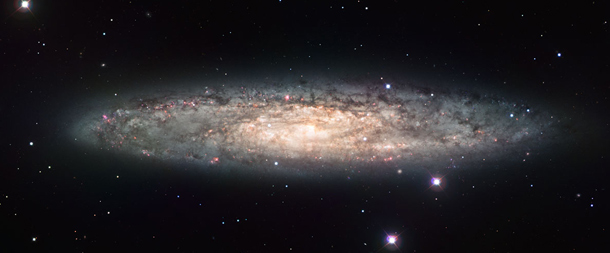I love big, splashy spiral galaxies. They are such eye candy, and of course their breadth and scale are magnificent. Sweeping, curved arms of stars and gas a hundred thousand light years long…
One of my favorites is NGC 253, a nearly edge-on spiral that lies roughly 11 million light years away in the constellation of Sculptor. I’ve seen it many, many times, but I was honestly surprised when a new image was released by the European Southern Observatory. I’ve never seen it like this:
Wow! Click to galactinate.
As you can see, it’s tilted pretty severely to our line of sight. You can clearly see the spiral arms, and the dust lanes wrapping around the galactic center. I was amazed to see the dust appears to be thicker on the top half than on the bottom. I was even more amazed to clearly see the bar – the elongated rectangular region in the center of the galaxy! That’s almost completely undetectable in a visible light image of the galaxy:

That’s how I’m used to seeing it: loaded with dust that hides the shape of the galaxy itself. The top image, taken by the new VISTA 4.1 meter telescope, is in the infrared, which cuts through most of the dust and shows cooler, redder stars. The bar in the center of the galaxy is formed due to the way the gravity of all the stars of the galaxy shapes the way they orbit the center. In our solar system, the Sun outmasses everything else, and dominates the gravity of the system. This makes the system fairly simple. But in a galaxy the mass is spread out, and bizarre effects can occur as the combined mass of the stars affects the overall galaxy. Spiral arms are one outcome of this, and bars are another.
One way to form such a bar is to have a big galaxy collide and merge with another galaxy. Interestingly, NGC 253 is a starburst galaxy, which means it’s making new stars at a prodigious rate. This can also happen when two galaxies merge, and their gas clouds collide. On top of that, other studies looking at the velocities of stars and gas in the galaxy also indicate a merger. It seems pretty clear NGC 253 had a very violent event happen to it in the recent past. I suspect this may explain the thicker dust on one side than the other too. It could be the remnants of the smaller galaxy, or perhaps the collision triggered huge amounts of star formation along one arm – dust is created when young, massive stars die. Perhaps I’m way off here, but so many odd things happening in one galaxy with one clear explanation for so many of them makes me suspicious.
But the most important thing to me is that here we have a galaxy I thought I was at least passingly familiar with, and it turns out to have some major features about which I hadn’t a clue. I suppose I could be embarrassed by that, but instead, quite honestly, it makes me glad! I don’t think familiarity breeds contempt, necessarily, but it does tend to dull the sense of wonder. And here I get to re-kick start that wonder. It’s not often anyone gets a chance to do that.
ESO/J. Emerson/VISTA. Acknowledgment: Cambridge Astronomical Survey Unit
Related posts:
- Barred for life
- Ten Things You Don’t Know about the Milky Way
- Incredible VISTA of the cosmos
- The Orion VISTA